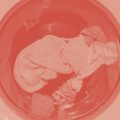After the Leftovers
"I saw you on my TV. You were looking right at me."
— "G'Day Melbourne," The Leftovers, season 2, episode 4.
Halfway through the second season of The Leftovers, Kevin drinks poison and dies. He falls to the floor, froth dribbling down his chin, and is buried in the ground. In the next episode, he wakes in a bathtub and splashes onto the tiled floor. The handheld camera gets close, framing Kevin's dripping face and shoulders as he looks for signs of recognition in the strange room. He looks everywhere but dead ahead. The camera trails him from a low angle as he stands, moving closer until Kevin looks straight into the mirror — and straight at us.
The episode "International Assassin" is The Leftovers' first departure from what we could call, simplistically, its real world. The show's protagonist appears to die and wake in some other place. It might be another dimension, an underworld or a limbo, a world in between the living and the dead, a waiting room; or it might be all in Kevin's head, a manifestation of his struggles with attachment and loss, his struggle with belief in family, his urge to flee. Over the course of its run, Kevin takes two more trips to this other world, and he returns each time.
Loss is an experience of coming up against a threshold between two irreconcilable realities. Presence and absence. The Sudden Departure split the world in two: between those who departed and those who remain, but also between those who forget and those who remember, between mourners and melancholics, between the impulse to find meaning from loss and the obliteration of meaning. When the show departs from its shared world, into the afterlife of Kevin's excursions, it doubles down on binaries: dead or not dead, lost or still here, beard or no beard, assassin or president, faith and doubt, remembering or forgetting. All these pairs are joined by conjunctions that function as mirrors, screens, and thresholds mediating what is seemingly irreconcilable.
Eugenie Brinkema argues that loss is traumatic to film form: "When a loved thing or one goes missing in a cinematic diegesis, it is a trauma not only to a psychologically invested character in the film—whose face traces, usually in close-up, the gestural expressions of sorrow—but also a formal trauma to film and its endlessly recuperative ability to make absent things present."1 As Brinkema describes, screens typically compensate for loss by denying it altogether (such as Patti's continued presence), framing the loss by the environment (such as Nora's focus on her empty kitchen table), or with a supplemental doubling (such as a character looking into a mirror). But the other world that Kevin enters is a more dramatic compensation, it takes the denial of loss from the show's regular vernacular and creates a whole world for it. It holds open a door to the other side of death.
As The Leftovers developed in its second and third seasons, the Sudden Departure became not a world-splitter but a refractor. The show's equivocation between hallucination and perception, presence or absence, living or dead, became more axiom than simple feature. How do you reckon with the irreconcilable thresholds of loss in the face of a screen that is already a spectral recuperation of presence? Kevin can come back from the dead because the show renders absence and presence as spectral spaces to be traversed. The show created a world to reflect its own spectrality back to itself, and Kevin's death is that screen, how The Leftovers looks at itself and its own incapacity in the face of absence. Kevin looking into the mirror, and looking at us, is not just "the screen watching us watching,"2 but a doubled move, the screen watching itself, made possible only by that most definitive of thresholds. Death is a screen, and we're watching it.
***
When we first meet him, Kevin is the police chief of Mapleton, New York, a position he inherited after his father was institutionalized. Over the course of the season, Kevin believes he is losing his mind; waking with no memory of what he has done amid plans he doesn't remember making; killing feral dogs with a bald man who might not be real; and by the second season seeing the specter of Patti Levin, the head of Mapleton's branch of The Guilty Remnant who killed herself in front of him after he kidnapped her while sleepwalking. The Leftovers is a show that's at home with equivocation, constantly trying to alienate us from our need to be certain in our beliefs. In fact, you know what The Leftovers really cares about by the questions it doesn't answer.
In the interview "Cinema and Its Ghosts," Jacques Derrida connects the cinematic experience to spectrality, and to a unique kind of believing, because cinema's "spectral dimension is that of neither the living nor the dead, of neither hallucination nor perception."3 Though in a different context, Derrida's insight offers a way to think about this show that is so committed to grappling with belief, and with the questions of absence and presence specific to the screen. The Leftovers is full of belief systems, variations of Christianity, older religions, primal beliefs, new cults and religious groups like the Guilty Remnant. But there is also an explicit connection between the diegetic apparitions on screen and the apparitions that are formally inherent to screens. Our eyes take something in, presented as if it's happening now, and we are caught in a double-knowing: "you believe without believing, but this believing without believing remains a believing."4 The screen is a threshold beyond which we can safely deposit our belief; a threshold that allows us to act as if we are seeing something true.
What happens when a character sees something that may or may not be physically there? Patti does not half-appear, she does not appear ghostly or translucent. She dresses in white as she did in life. She sits in the passenger seat and the camera affords her an equal share of reverse shots. The show depends on external markers to let us know that what Kevin sees (and what we see with him) is not what others are seeing. It's a matter of perspective. In one episode, Kevin yells at Patti in front of a shopkeeper and his son, but they neither see nor hear Patti, and the shopkeeper reacts with fear and hostility. Patti haunts Kevin. Her presence intensifies his preoccupation with his mind's instability. But she also interrupts our general assumptions about things that appear — that they're really there — so that even on a screen's spectral dimension, we see a world that makes sense. But because the show refuses us a clean answer, we take a more active hand in our "believing without believing that remains a believing." A show so deeply about a loss without possible compensation carries its own anxieties about the screen's endless recuperability of presence.
Kevin's death, his transfer to this other world, is a leap, a key change; the show asks us to believe something new. Patti, the spectral figure that leaves her trace on the world, is switched for the spectral world that absorbs Kevin. And this spectral world on screen is in part a belief in an absence that is really an alternative presence. That death is not absence itself but a threshold to an inverted, photonegative existence.
This other world Kevin enters recalls what Northrop Frye defines, idiosyncratically, as the "apocalyptic" in literature, "a world of total metaphor, in which everything is potentially identical with everything else, as though it were all inside a single infinite body."5 This other world might be unreal in the sense that it is only personal, perhaps spawned entirely out of Kevin. The episodes that take place in this other world are replete with proliferating symbols that seem impossible to pin down. Obsessed with repetitions, references, and doppelgangers: hotels and liminal spaces, TV screens turning on of their own power, a dresser filled with uniforms, trapped birds, water as medium, water as life giving, water as life taking. Crucially, though these episodes seem to follow their own rules, their consequences are always real.
But this other world is also an entryway into more fantastical genres for The Leftovers. The show's self-consciousness, the way it holds this other world in a suspense of reality/unreality, allows it to play with genre without being subjected to genre. On his trips Kevin dons a costume like a fantasy of masculinity: police chief, assassin, US president. Perhaps this speaks to some ingrained mythology of gender for Kevin, but it is also the fantasy of a man with problems that can be solved. The way to deal with an absence that keeps manifesting as presence is to kill what is already dead.
The result is that Kevin maintains two identities at once, he is a participant in a script (Kevin Garvey from Mapleton) and the role itself (Kevin the assassin). Kevin moves through tropes that allow him to participate in a script that has been outlined for him in advance. His adventures in this other world are a commentary not just on acting or performance, but on our identification and participation in what we watch. In each arrival to this other place, Kevin enacts a different performance, which allows him to perform in the third person, and access a kind of truth that he cannot face in life.
***
The Leftovers is a show of the screen time era, which means, as Phil Maciak points out, it is self-aware and even preoccupied with screens.6 The show's forays into an alternate dimension are symptomatic: when Kevin first emerges from the bathroom in "International Assassin," the television blares, rippling static, bathing our confused protagonist in cool blue light. Later, that same screen becomes a medium of communication between Kevin and his father, who gives him crucial advice. In the seventh episode of the third season, "The Most Powerful Man in the World (and His Identical Twin Brother)," one of Kevin's missions requires talking with the president of Australia (through a screen). Mirrors, too, become a privileged kind of screen in all of Kevin's departures: it's an orienting figure, it stands in for the frame, for our screen; later the mirror becomes a medium of transportation, a literalized manifestation of the cinematic cut. These screen occurrences are particularly concerned with the medium's presencing powers: its ability to present a person, a figure, a body.
The second time Kevin dies is in "I Live Here Now," the tenth episode of the second season. John Murphy, a hurt, angry vigilante who is also Kevin's neighbor, shoots Kevin in the chest, leaving him to bleed out. Kevin returns to the underworld where he dons the police uniform. Downstairs, a bearded man tells Kevin he must sing karaoke to return to the world. Kevin at first refuses but eventually relents and sings, aptly, Simon and Garfunkel's "Homeward Bound."
A blue spotlight shines on Kevin when he starts singing. We see him from the crowd. The second season of The Leftovers is its most chromatically dramatic, and the color blue is associated with night and with Kevin's mission in the other world. But before he sings the first "home," the perspective shifts to a close up from Kevin's shoulder. The blue light blues the whole screen. This scene unfolds entirely in extreme close-ups of Kevin as the song gradually breaks down his defenses. In another close up, Kevin is framed from his eyebrows to his mouth, the background is dark and immaterial, as if Kevin were not on a stage but in no place at all. It's not just Justin Theroux's halting, quivering performance that conveys the song's force, but the close-ups and the blue light that minimize everything outside of Kevin. Though the words are not Kevin's original words, he enacts the words, and they provide him with emotional truth. He is reflected to himself.
By its third season, the show accommodates extremes. Evidence is mounting that Kevin can come back from the dead, and Kevin's friends follow him to Australia, believing that he might be Jesus or some sort of messiah. They ask him to go back to the other place because they have messages for the dead. So, Kevin submits to drowning. When he awakes in the other world, Kevin is an international assassin being dragged out of retirement to kill the US president, who is about to start an unsanctioned nuclear war. Kevin is the only person who can get close enough to do the job because the president is his identical twin.
Kevin's first foray into the other world is punctuated by his gaze into the mirror, and into the camera. In his second entrance, Kevin realizes where he is only when he sees his reflection. The mirror lets Kevin recognize himself as Kevin, this place as the place he goes when he dies. This episode introduces a new device, when Kevin sees his reflection, he is transported from one body (assassin) to the other (president). Able to fully embody the president or the assassin as needed. Reflection is a medium of transportation for Kevin's consciousness.
But this transference of Kevin from one body to the other is less physical than cinematic. In actuality, there is nothing that would define one body as Kevin and the other as different, except through the cut. The first time it happens, it jars him, and Theroux makes a show of orienting himself, but all that is actually happening is a match cut: Kevin looks into his reflection, and the reflection answers back.
Soon, President Kevin learns that the plot is part of a scheme hatched with his Secretary of Defense (Patti Levin, also summoned out of retirement) to end the world. But as a deterrent for nuclear war, the key to the "nuclear football" was installed in his twin's chest and President Kevin will have to cut him open and stick his hand in there to grab it. Neither Kevin wants any part of this until they read the ending of a romance novel about a man who runs away from the love of his life because he is a coward. The story is a clear analogy for Kevin, and assassin Kevin realizes that destroying this other world is the only way for him to stop returning. For Kevin, rejecting his cowardice means living in the real world and going after Nora. As in the season 2 finale, clarity impinges itself on Kevin (and the show) only through a performance of another's words. Kevin enters an action movie to read a romance novel to recognize something about himself.
***
If the close-up is the show's language for emotional truth, then the wide shot is a more distant witnessing. When Kevin and Patti walk up to the well in "International Assassin," they are shot from a high angle with an ultrawide lens, the cracked ground bending and stretching at the edge. Though Kevin eventually enters the well, the recurring image from the scene is Kevin pushing Patti off the well's ledge. In "The Most Powerful Man," Kevin's time in the other place ends with President Kevin and Secretary Levin watching the nuclear warheads streaming across the sky like a meteor shower. It is another wide shot, the blue sky coloring the frame; skyscrapers on either side of the pair, bending in on each other. Then: a flash of white.
With a nuclear apocalypse, Kevin uncomplicates himself and so does the show. If this other world is a screen world, a screen within a screen, how the screen sees itself, Kevin's destruction is a form of rejection. Representation is rooted in compensation for loss, and it gains its power from that loss. It makes presence out of absence, something that feels real for us; and yet for Kevin this is an escape, a shelter that keeps him from remaining in a world that has a hole in it. By the third season, the show is not just reflecting its own spectrality, but critiquing and refracting it. The resolution to Kevin's (and the show's) final death-that's-not-death is one that promises a final ending, a way to return absence to absence. It ends.
Jorge Cotte is a writer and critic living in Chicago. He primarily writes about aesthetics and affect in film and television. His work has appeared in The Nation, Los Angeles Review of Books, and The New Inquiry.
References
- Eugenia Brinkema, The Forms of the Affects (Durham: Duke University Press 2014), 94.[⤒]
- Phillip Maciak, Avidly Reads Screen Time (New York: New York University Press 2023), 2.[⤒]
- Antoine de Baecque and Thierry Jousse, "Cinema and Its Ghosts: An Interview with Jacques Derrida," trans. Peggy Kamuf, Discourse 37 (2015): 27.[⤒]
- de Baecque and Jousse, 27.[⤒]
- Northrop Frye, Anatomy of Criticism: Four Essays (Princeton: Princeton University Press, 1957), 136.[⤒]
- Maciak, Avidly Reads Screen Time, 37-63.[⤒]










